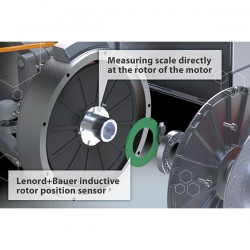Products On Show
The latest sensor technology for future powertrains
Lenord+Bauer
 Lenord+Bauer has been a specialist in motor feedback sensor technology for electric traction motors for more than 30 years. At IVT in Cologne, the company will present its brand-new inductive rotor position sensor. The sensor technology is suitable for replacing currently used technologies such as variable reluctance resolvers or magneto-resistive sensors in future generations of powertrain.
Lenord+Bauer has been a specialist in motor feedback sensor technology for electric traction motors for more than 30 years. At IVT in Cologne, the company will present its brand-new inductive rotor position sensor. The sensor technology is suitable for replacing currently used technologies such as variable reluctance resolvers or magneto-resistive sensors in future generations of powertrain.
The sensor provides highly accurate and offset-free SIN and COS signals as single-ended or differential signals. As a system that fully encloses the motor shaft, the sensor requires only a few precise installation tolerances and is therefore very well suited for mass production. Due to the self-diagnostics in the sensor, ASIL C is achievable as a single sensor application, ASIL D if the sensor will be designed as a redundant system. The sensor is suitable for high-speed application with more than 30,000rpm.
Lenord+Bauer tailors the sensor configuration for the respective motor configuration. This is a response to the general trend of building motors ever more compactly and thus having less space for sensors. Especially for axial-flux machines, which have a very narrow design, it is a decisive advantage if the complete sensor system requires less installation space in the axial direction and can be designed as a hollow shaft version at the same time. The magnet-free technology allows the sensor and measuring scale to be placed near the strong magnets of the motor. These advantages are also available for radial-flow machines. The configuration process will be demonstrated virtually in CAD at the booth on various sample motors. In addition to different sensor dimensions, Lenord+Bauer will present different cabling and target solutions for the motor shaft.
Lenord+Bauer will also present a small 48V-based PM motor test bench to demonstrate the advantage of high-precision angle measurement. This will involve running a cycle with different loads on the motor and comparing the response torque curves when using the original sensor and Lenord+Bauer’s four-pole inductive sensor.
Stand: IVT25